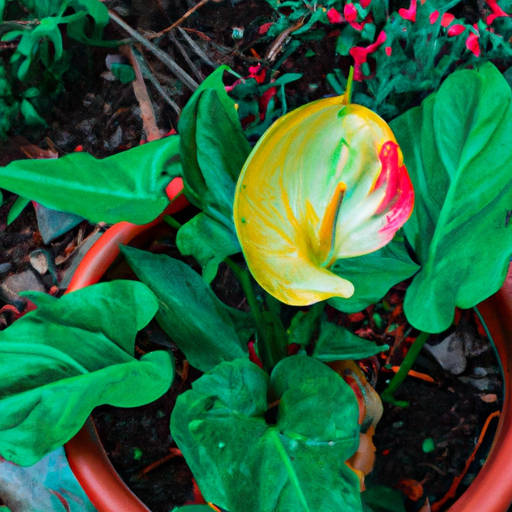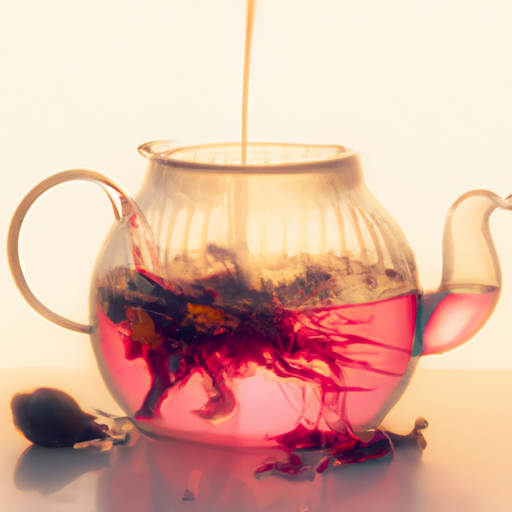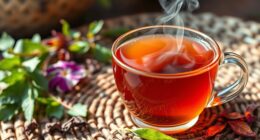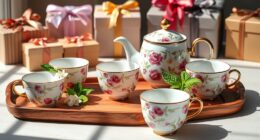Picture the vivid colors of a summer garden, filled with shades of purple, pink, and white swaying in the sunlight. Picture yourself gently picking petals from a stunning Echinacea flower, releasing a fragrance of earthy sweetness into the air.
As a lover of herbal teas and their many health benefits, I couldn’t resist exploring the wonders of Echinacea tea. Known for its immune-boosting properties and ability to alleviate cold symptoms, this herbal infusion is a true powerhouse.
In this article, I will guide you through the process of making Echinacea tea from these exquisite flowers. From gathering and preparing the petals to brewing the perfect cup, I will share the secrets to creating a flavorful and healthful beverage.
So, grab your teapot, let’s embark on a journey of wellness and indulgence with Echinacea tea.
Key Takeaways
- Echinacea tea is known for its immune-boosting properties and alleviating cold symptoms.
- It should be prepared by boiling water and adding a teaspoon of dried echinacea flowers per cup, steeping for 10 minutes, and then straining.
- The tea can be sweetened with natural options like honey or stevia, and flavored with lemon, mint, cinnamon, or cloves.
- Excessive consumption should be avoided, as it may lead to gastrointestinal discomfort, and it should not be taken continuously for more than 8 weeks.
Introduction to Echinacea and its Health Benefits
If you’re looking to boost your immune system and improve your overall health, echinacea is the flower for you! Echinacea, also known as purple coneflower, has long been recognized for its medicinal properties.
Extensive echinacea research has shown that it can enhance the body’s natural defense mechanisms, making it an excellent choice for preventing and treating various ailments. It is believed to stimulate the production of white blood cells, which play a crucial role in fighting off infections. Additionally, echinacea has been found to possess antiviral and anti-inflammatory properties, making it effective against colds, flu, and other respiratory conditions.
When it comes to echinacea dosage, it is recommended to follow the instructions provided on the product label or consult a healthcare professional for guidance. The dosage can vary depending on factors such as age, overall health, and the form of echinacea being used (such as capsules, tinctures, or teas). It is important to note that echinacea should not be taken continuously for more than 8 weeks, as prolonged use can lead to a decrease in its effectiveness.
Now that we understand the health benefits of echinacea, let’s move on to the next section about gathering and preparing echinacea flowers.
Gathering and Preparing Echinacea Flowers
When gathering and preparing Echinacea flowers, it’s important to start by identifying the correct plant. Look for the distinctive purple or pink petals and the cone-shaped center.
Harvest the flowers in the morning, when they’re fully open and at their peak potency.
After gathering, dry the flowers in a well-ventilated area away from direct sunlight.
Once dried, store the Echinacea flowers in an airtight container to preserve their medicinal properties.
Identifying and Harvesting Echinacea Flowers
After carefully inspecting the vibrant purple petals of the echinacea flower, it’s time to gather and prepare them for making tea. Here are three important things to consider when harvesting echinacea flowers:
-
Harvesting Techniques: To ensure the best quality, choose fully mature flowers that’ve just opened. Use a sharp pair of scissors or pruning shears to cut the flower heads, leaving about 2-3 inches of stem attached.
-
Medicinal Properties: Echinacea flowers’re known for their medicinal properties, which include boosting the immune system and reducing inflammation. Harvesting the flowers at the right time ensures that these beneficial compounds’re preserved.
-
Proper Handling: Handle the flowers with care to avoid damaging the delicate petals. Place ’em in a basket or breathable bag to prevent wilting and bruising during transport.
Now that we’ve gathered the echinacea flowers, let’s move on to the next step of drying and storing ’em for future use.
Drying and Storing Echinacea Flowers
Once the vibrant purple petals have been carefully harvested, it’s time to dry and store the delicate echinacea flowers for future use.
Drying techniques are crucial in preserving the potency and flavor of the flowers. To dry echinacea flowers, it’s best to hang them upside down in a well-ventilated area away from direct sunlight. This allows for optimal air circulation and prevents mold or mildew growth. It usually takes about two weeks for the flowers to fully dry.
Once dried, store them in airtight containers, such as glass jars, in a cool and dark place to maintain their medicinal properties. Proper storage is essential to prevent moisture and light from degrading the flowers.
Now that the echinacea flowers are properly dried and stored, let’s move on to the next step: brewing echinacea tea.
Brewing Echinacea Tea
To brew Echinacea tea, you’ll need to gather a handful of vibrant Echinacea flowers. These flowers will infuse your tea with their healing properties, just like the rays of the sun infuse warmth into a cozy room. Echinacea tea is not only delicious but also offers numerous health benefits.
The brewing techniques for Echinacea tea are quite simple. Start by boiling water, and then add a handful of fresh or dried Echinacea flowers to a teapot or infuser. Let the flowers steep for about 10 to 15 minutes to allow the medicinal compounds to be released into the water. The longer you steep, the stronger the tea will be, so adjust the steeping time according to your preference.
Once the steeping is complete, strain the tea to remove the flowers and pour it into your favorite cup.
Echinacea tea is known for its immune-boosting properties and can help alleviate symptoms of the common cold and flu. It is also rich in antioxidants, which help protect the body against free radicals and promote overall wellness.
Now that you know how to brew Echinacea tea, let’s explore how to enhance its flavor with a few simple additions.
Enhancing the Flavor of Echinacea Tea
After brewing your Echinacea tea, there are several ways to enhance its flavor and aroma. By experimenting with different flavors, you can create a unique and enjoyable tea experience.
One way to enhance the aroma of your Echinacea tea is by adding a slice of lemon or a few sprigs of fresh mint. The citrusy scent of lemon or the refreshing aroma of mint can complement the earthy taste of Echinacea and provide a delightful sensory experience.
Another option to enhance the flavor is to add a touch of honey or stevia. These natural sweeteners can balance out any bitterness in the tea and add a subtle sweetness that pairs well with the herbal notes of Echinacea. You can also try adding a pinch of cinnamon or a dash of ginger for a warming and spicy twist.
Experimenting with different flavors can help you find the perfect combination that suits your taste preferences. Once you have enhanced the aroma and flavor of your Echinacea tea, you can move on to the next step of adding other herbal ingredients for added benefits.
Adding Other Herbal Ingredients for Added Benefits
Enhance your Echinacea tea experience by exploring the benefits of incorporating additional herbal ingredients.
Creating herbal tea blends can’t only add a new dimension of flavor to your tea, but also provide additional health benefits.
Combining Echinacea with other herbs can create a powerful blend that supports your immune system and overall well-being.
One popular herb to pair with Echinacea is elderberry. Elderberry is known for its antiviral properties and can help boost the immune system. Adding a few dried elderberries to your Echinacea tea can give it a delicious and fruity taste while also enhancing its immunity-boosting effects.
Another herb to consider is chamomile. Chamomile is well-known for its calming properties and can help promote relaxation and sleep. By adding a few dried chamomile flowers to your Echinacea tea, you can create a soothing blend that not only supports your immune system but also helps you unwind after a long day.
Other herbs that can complement Echinacea include peppermint, ginger, and lemon balm, each with their own unique health benefits.
Experimenting with different herbal combinations can be a fun and creative way to customize your Echinacea tea to your specific needs.
Transitioning into the next section about sweetening and flavoring options, you can further enhance your herbal tea blend by exploring different ways to add sweetness and flavor.
Sweetening and Flavoring Options
After exploring the benefits of adding other herbal ingredients to enhance the potency of our homemade echinacea tea, let’s move on to the next step: sweetening and flavoring options. While echinacea tea has a unique earthy taste, some may prefer to add a touch of sweetness or a burst of flavor to their brew. Fortunately, there are various natural options available for those seeking to customize their tea.
To sweeten your echinacea tea, you can turn to natural sweeteners like honey or stevia. These alternatives not only provide a pleasant taste but also offer additional health benefits. Honey, for example, has antimicrobial properties and can soothe a sore throat, making it a wonderful choice for those seeking relief from cold symptoms. Stevia, on the other hand, is a calorie-free option for those watching their sugar intake.
When it comes to flavoring ideas, the possibilities are endless. You can experiment with adding a slice of lemon or a sprig of fresh mint for a refreshing twist. Alternatively, you may opt for a hint of warmth by infusing your tea with a cinnamon stick or a few cloves. These additions not only enhance the taste but also bring their own set of health benefits, such as aiding digestion or boosting the immune system.
Now that we’ve explored the sweetening options and flavoring ideas for our echinacea tea, it’s time to move on to the final step: serving and enjoying this delightful brew.
Serving and Enjoying Echinacea Tea
To fully savor the rich flavors and health benefits of this herbal infusion, one can indulge in the ritual of steeping and sipping a warm cup of echinacea tea. When it comes to serving techniques, it’s important to note that echinacea tea is typically enjoyed on its own, without any additional sweeteners or flavorings. This allows the natural taste and aroma of the echinacea flower to shine through.
To prepare the perfect cup of echinacea tea, start by boiling water and adding a teaspoon of dried echinacea flowers per cup. Let it steep for about 10 minutes to extract the beneficial compounds. Once steeped, strain the tea and pour it into a cup. You can enjoy it hot or let it cool down for a refreshing iced tea option.
Now, let’s delve into the health benefits of echinacea tea. This herbal infusion is known for its immune-boosting properties, thanks to its high concentration of antioxidants and anti-inflammatory compounds. Regular consumption of echinacea tea may help strengthen the immune system, reduce the duration of cold and flu symptoms, and support overall well-being.
However, it’s important to understand the potential side effects and precautions associated with echinacea tea, which we’ll explore in the next section.
Understanding the Potential Side Effects and Precautions
One interesting statistic to note is that studies have shown that excessive consumption of echinacea tea may lead to gastrointestinal discomfort in some individuals.
It’s important to be aware of the potential side effects and precautions associated with using echinacea tea. While echinacea is generally considered safe for short-term use, it’s recommended to follow the dosage recommendations provided on the product label or consult with a healthcare provider. Long-term use of echinacea tea should be done under the guidance of a healthcare professional.
It’s also important to be mindful of possible interactions with medications you may be taking. Echinacea tea may interact with certain medications, such as immunosuppressants and medications that affect liver enzymes. It’s advisable to consult with your healthcare provider before incorporating echinacea tea into your daily routine.
In addition, some individuals may have contraindications or allergic reactions to echinacea tea. If you have a known allergy to plants in the daisy family, such as ragweed or marigolds, it’s recommended to avoid using echinacea tea. If you experience any adverse reactions, such as difficulty breathing or swelling, discontinue use immediately and seek medical attention.
While echinacea tea has many potential health benefits, it’s important to be aware of the potential side effects, precautions, and dosage recommendations. It’s always advisable to consult with a healthcare provider before incorporating echinacea tea into your daily routine.
Transition sentence: Now that we’ve discussed the potential side effects and precautions, let’s explore how to incorporate echinacea tea into your daily routine.
Incorporating Echinacea Tea into Your Daily Routine
Try adding a splash of honey and a squeeze of lemon to your morning routine by incorporating the immune-boosting benefits of echinacea tea. Echinacea tea is renowned for its numerous health benefits, making it a great addition to your daily routine.
Not only does it support your immune system, but it also possesses anti-inflammatory properties and aids in reducing symptoms of the common cold and flu.
There are various ways you can incorporate echinacea tea into your daily routine. One option is to start your morning with a warm cup of echinacea tea instead of your usual coffee or black tea. You can also enjoy it as a mid-morning or afternoon pick-me-up.
Alternatively, you can make a large batch of echinacea tea and refrigerate it to enjoy as a refreshing iced tea throughout the day. Another option is to add echinacea tea bags to your water bottle and sip on it throughout the day for a continuous immune boost.
Echinacea tea offers a multitude of health benefits and can easily be incorporated into your daily routine. By adding this herbal tea to your morning or afternoon routine, you can reap the immune-boosting benefits it provides.
Transitioning into the next section, let’s explore the different ways you can prepare echinacea tea for optimal results.
Conclusion and Final Thoughts
Incorporating echinacea tea into your daily routine can provide a multitude of health benefits, making it a refreshing and immune-boosting addition to your morning or afternoon.
As we conclude our discussion on the benefits of echinacea tea, it’s important to highlight the final thoughts about this herbal beverage.
Firstly, echinacea tea is known for its immune-boosting properties. It contains active compounds that stimulate the production of white blood cells, enhancing our body’s defense against infections and viruses. By incorporating echinacea tea into your daily routine, you can strengthen your immune system and reduce the risk of falling ill.
Secondly, echinacea tea has anti-inflammatory properties, making it beneficial for individuals dealing with chronic inflammatory conditions such as arthritis or respiratory issues. Regular consumption of this herbal tea can help alleviate symptoms and promote overall well-being.
Lastly, echinacea tea is a natural source of antioxidants, which play a crucial role in neutralizing harmful free radicals in our body. By incorporating echinacea tea into your daily routine, you can protect your cells from oxidative stress and potentially reduce the risk of chronic diseases.
Integrating echinacea tea into your daily routine can bring numerous health benefits, including immune-boosting properties, anti-inflammatory effects, and antioxidant protection. So, why not make echinacea tea a part of your daily self-care regimen? Cheers to your health!
Frequently Asked Questions
Are there any alternative methods for making tea from echinacea flowers?
There are indeed alternative brewing methods for making tea from echinacea flowers. These methods include cold brewing, where the flowers are steeped in cold water for several hours, and using a French press to extract the medicinal properties.
Echinacea tea has numerous health benefits, such as boosting the immune system, reducing inflammation, and aiding in respiratory health. Regular consumption of echinacea tea can provide a natural and effective way to support overall well-being.
How long does it take for echinacea tea to have an effect on the immune system?
It usually takes about a week of consistent consumption for echinacea tea to have a noticeable effect on the immune system. However, this can vary depending on individual factors such as overall health and immune function.
While there are alternative methods for making echinacea tea, the most common method involves steeping the dried echinacea flowers in hot water for 10-15 minutes. This allows the active compounds in the flowers to be extracted and provide immune-boosting benefits.
Can echinacea tea be safely consumed by children?
Echinacea tea can be safely consumed by children, but it’s important to consider safety concerns. While echinacea is generally well-tolerated, potential side effects in children include upset stomach, rash, and allergic reactions. It’s advisable to consult with a healthcare professional before giving echinacea tea to children, especially if they have underlying health conditions or are taking other medications. Overall, it’s important to prioritize the safety and well-being of children when considering the use of echinacea tea.
Are there any specific types of echinacea flowers that are recommended for making tea?
There are several specific echinacea varieties that are recommended for making tea. These include Echinacea purpurea, Echinacea angustifolia, and Echinacea pallida. These varieties are commonly grown for tea production due to their high levels of beneficial compounds.
They can be cultivated in a garden by providing well-drained soil, full sun, and regular watering. Once the plants have matured, the flowers can be harvested and used to make tea with their immune-boosting properties.
Can echinacea tea be used to treat specific medical conditions, such as colds or allergies?
Echinacea tea is often used as an herbal remedy for various conditions such as colds and allergies. It’s believed to stimulate the immune system and reduce symptoms. However, it’s important to note that the effectiveness of echinacea tea in treating these conditions is still debated among experts. Compared to other herbal remedies, echinacea tea may have similar benefits but with potential side effects such as nausea, stomach pain, and allergic reactions. Consult a healthcare professional before using echinacea tea for medical purposes.
Conclusion
In conclusion, incorporating echinacea tea into your daily routine can be a beneficial way to support your overall health and well-being. It’s immune-boosting properties and potential ability to reduce inflammation make echinacea tea a natural and delicious option for promoting a strong immune system.
Just like a gentle breeze that revitalizes the senses, sipping on a warm cup of echinacea tea can invigorate your body and provide a soothing sensation. So why not give it a try and experience the power of echinacea for yourself? Cheers to a healthier you!










